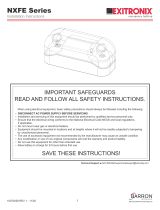
PLACING THE UNIT IN SERVICE
Loosen the two cover retaining screws on the sides of the unit, rotate the heads for clearance, and
remove the cover by lifting it up and outwards.
If lighting heads will be retained in the top mounted position, go to step 3. If lighting heads are to be
relocated to side mounted position, proceed as follows:
a. Snap out the lighting head knockouts on the sides of the unit.
b. Loosen the locking nut that retains the stem for each lighting head.
c. Slide each lighting head out of its present slot.
Note: It is not necessary to disconnect the lighting head leads from the circuit board.
d. Insert the stem of each lighting head into the side opening slots.
e. Tighten the locking nut on each stem so that the lamp heads turn with some resistance.
f. Plug the top mounted opening slots with the hole plugs contained in the hardware pack.
Fasten enclosure to electrical outlet box and/or wall surface using appropriate hardware.
Note: The enclosure can be mounted to 3", 4" octagon, or 4" square electrical boxes, and to
standard plaster rings. Large enclosures have additional keyhole slots for surface mounting. a "
7/8" diameter knockout is provided on the top and on each side of the enclosure for surface wiring
conduit.
Connect remote lamps (if used) to blue (+, fused) and Yellow(-) leads (Fig.1).
Connect 120 or 277VAC input connections to transformer (Fig.1). Connect green wire to building ground.
Note: Insulate the unsuded transfomer lead to prevent potential shock hazard.
Dertermine proper battery orientation from Fig.2 (single harness lead connection) or Fig.3 (double
harness lead connection). Batttery is positioned to the left of the circuit board. Remove protective liner
from double sided tape, located on floor of enclosure.
Note: a 1/4" space (minimum) is required between the front of the battery and the inner lip of the
enclosure to provide clearance for cover. Place battery into enclosure, and press down firmly to
secure battery to enclosure.
Connect positive (+, red) and negative (-, yellow) battery harness leads from printed circuit board to
corresponding battery terminals as shown in Fig.2 or Fig.3.
Check all wiring for loose or missing connections.
Replace cover. Be sure that each "star washer is properly positioned between the screw head and the
outer surface of the cover. Tighten retaining screws. Adjust lighting heads to desired position.
Energize unit with AC power. Press and hold the “TEST” button (see Fig. 1 for “TEST” button location) to
confirmillumination and proper aiming of emergency lamps. (“AC ON” indicator LED should go off).
Release the “TEST” button; emergency lamps should extinguish. Normal operation begins.
Normal Operation: with power supplied, “AC ON” LED indicator is illuminated and emergency lamps are
off.
1.
2.
3.
4.
5.
6.
7.
8.
9.
10.
11.
ROUTINE TEST CYCLING
Monthly:
If there has been no power failure, press and hold the “TEST” button for at least thirty (30)
seconds to confirm emergency lamp operation. Release “TEST” button to return to battery charging mode.
Once a year:
Performa full battery conditioning cycle by de-energizing the AC circuit to which the unit is
connected, and allow the unit to operate for ninety (90) minutes on battery power. Following successful test,
energize AC circuit to begin battery charging cycle.
Note: AC ON LED blinks when battery is fully charged.
REPLACING BATTERIES
De-energize the AC power supply to the unit.
Remove enclosure cover.
Disconnect positive (+, red) battery lead.
Remove defective battery. Recycle responsibly. Replace with genuine manufacturer battery only.
Place new battery in enclosure. Make connections following steps outlined above.
Test unit.
REPLACING EMERGENCY LAMP(S)
De-energize the AC power supply to the unit.
Remove enclosure cover.
Disconnect positive (+, red) battery lead.
Loosen the locking nut that retains the stem for each lighting head.
Slide lighting head out of its slot.
Insert the stem of each lighting head into the side opening slots.
Tighten the locking nut on each stem so that the lamp heads turn with some resistance.
Test unit.
1.
2.
1.
2.
3.
4.
5.
6.
1.
2.
3.
4.
5.
6.
7.
8.
PLACING THE UNIT IN SERVICE
GREEN
GREEN
B+
B-
-
-
+
+
L2+
L1-
L2-
L1+
B+
B-
-
-
+
+
L2+
L1-
L2-
L1+
Remote DC lamps
Negative (-) Lead(s)
Remote DC lamps
Positive (+) Lead(s)
With "On-Board" Fuse
Remote DC lamps
Positive (+) Lead(s)
With "Off-Board" Fuse
Transformer
120VAC - White & Black
277VAC - White & Red
Note: Potential Shock
Hazard-Instulate Unusead Lead
Test Switch
"AC On" LED
Transformer Ground Wire (Green)
Double Sided Tape
Ground Wire (Green)
Cover Retaining
Screw & Washer
Yellow Negative (-)
Battery Lead Red Positive (+)
Battery Lead
Remote DC Lamps
Negative (-) Lead(s)
Remote DC Lamps
Positive (+) Lead With
"On-Board" Fuse
Fig. 1 Lead-Calcium Battery Basic Wiring
Fig. 2 Single Harness Lead Connection Lead-Calcium Battries





